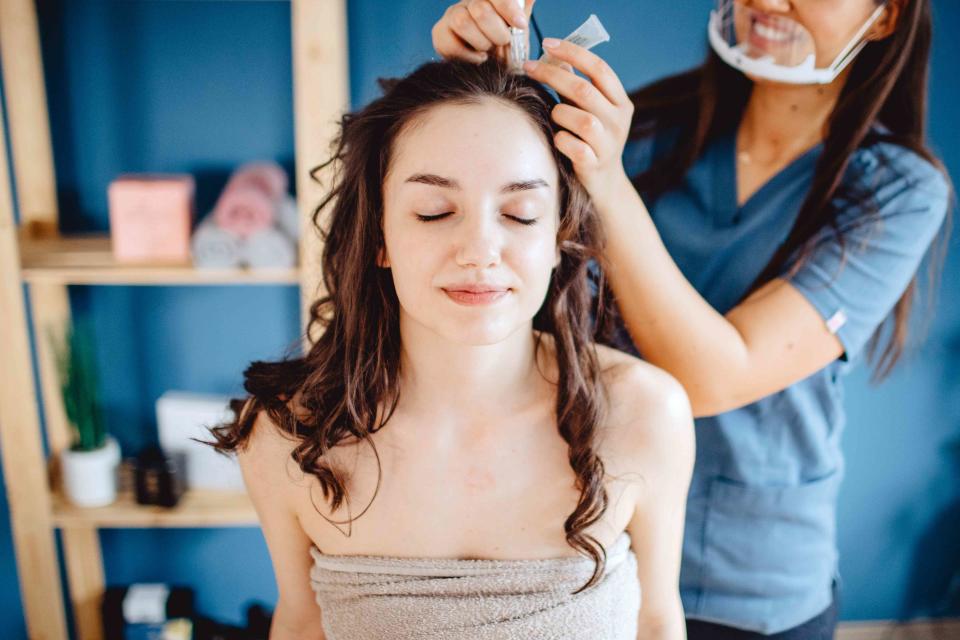Could Microneedling Your Scalp Offer New Hope for Hair Loss?
We asked dermatologists whether or not the trendy procedure can be applied to the scalp.

Getty Images
In the ever-evolving world of hair care and restoration, a new contender has appeared on the scene: microneedling for the scalp. Promising to stimulate hair growth and combat hair loss, the technique has received a lot of attention lately, but is it truly a solution for those seeking to restore their crowning glory?
What Is Mirconeedling?
Microneedling, scientifically known as percutaneous collagen induction therapy, involves using a handheld device with tiny needles to create micro-punctures in the skin. The process is meant to induce controlled micro-injuries, triggering the skin's natural healing response. According to board-certified dermatologist Jodi LoGerfo, MD, “microneedling is widely recognized for its effectiveness in treating acne scarring, enlarged pores, wrinkles, and stretch marks and has also been explored for its potential role in aiding hair growth.”
Can Microneedling Help Hair Growth?
“To me, the outcomes related to microneedling as a treatment for hair loss seem limited,” Dr. LoGerfo says. “The effectiveness of microneedling for hair loss likely depends on the underlying cause of the hair loss and individual factors such as the severity of the condition and the patient's overall health," sdds Certified trichologist Isfahan Chambers-Harris, Ph.D, Morehouse School of Medicine, and founder of Alodia Haircare,
As far as hair loss goes, there are only two drugs approved by the FDA for treating hair loss—topical minoxidil and oral finasteride, though the latter is not approved for use in women.
However, used in conjunction with topical minoxidil, microneedling shows promise. By creating micro-channels in the scalp, microneedling helps enhance the absorption of topical minoxidil, potentially increasing its efficacy. Additionally, the micro-injuries induced by the needles may trigger a wound-healing response, leading to increased blood flow and collagen production around hair follicles, promoting thicker and faster hair regrowth.
“But this is mostly hypothesized—there are no great studies,” cautions Dr. LoGerfo. In a study, a side treated with the combined therapy of microneedling and minoxidil showed greater results than the side treated with minoxidil by itself. Dr. LoGerfo adds that microneedling for hair growth should only be performed by licensed professionals. Since the procedure involves breaking the skin, there is a risk of infection if not done correctly. Furthermore, combining microneedling with topical minoxidil could cause skin irritation, making professional guidance vital to ensure proper application and monitoring.
How is Microneedling Performed?
For microneedling alone, a topical anesthetic is first applied for 30 to 60 minutes to numb the area. The anesthetic is then removed, and microneedling is performed using a pen or roller, with multiple passes as required.
When combining microneedling with topical minoxidil, the same process is followed, but after the initial application of topical medication, additional passes of microneedling are performed to enhance absorption through the micro-channels.
What are Some Alternatives to Microneedling?
Platelet rich plasma (PRP) was originally a treatment that promoted healing in injured joints. Now it is an emerging treatment to help regrow hair and improve the quality of your existing hair.
“There are virtually no side effects from PRP, except for a mild feeling of pressure at the injection site,” Dr. LoGerfo says.
During a PRP treatment, your blood is drawn and spun in a centrifuge to separate out the platelets and plasma. Then, the plasma is injected into the scalp where hair loss has occurred to repair blood vessels, promote cell growth and wound healing, and stimulate collagen production. “We began using PRP in dermatology after researchers found that high concentrations of platelets in plasma cells help promote hair growth by prolonging the growing phase of the hair cycle,” Dr. LoGerfo says.
Dr. Chambers-Harris confirms that PRP has shown potential in promoting hair growth and increasing hair density in treated areas. “Injected monthly into the scalp, PRP therapy targets hair loss by activating the wound healing response, prolonging the hair growth phase, and ultimately leading to visible improvements in hair density after three to six months,” she says.
Hair growth serums can also help to promote the healthy growth of new hair, Dr. Chambers-Harris says. “But always consult with your dermatologist or hair loss specialist to understand the root cause of your hair loss before attempting to treat it,” she says.
For more Real Simple news, make sure to sign up for our newsletter!
Read the original article on Real Simple.

